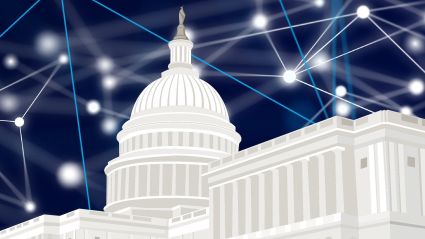
In This Newsletter
FinTech for Good
MiCA Comes Online for Stablecoin
Banking on the Future
FinTech for Good
Current events have shown the necessity of bringing together diverse viewpoints to shape our future. As part of our work in the FinTech program, we place importance on calls to action that include driving the financial sector to take stock of the good it is deploying through innovative technology. In moments of uncertainty, we work to unify around building communities, markets, and technology that enable meaningful lives. Comprehensive FinTech policy is one of the many tools we can and should leverage to this end.
Expanding on these core ideas, Nicole Valentine was interviewed for the Fintech Times feature “FinTech a Tightrope: Balancing Profitability with Purpose.” The article explores the idea of “FinTech for good” and how diversity, equity, and inclusion can be keys to sustainable and ethical growth.
Valentine was quoted saying, “At every stage of innovation the phrase ‘for good’ could have been included in the tagline to reflect the immense value that was and continues to be derived from transformational technologies. We could have written - automobiles for good as mobility is a driving force for equality and opportunity. Railroads for good, as interstate commerce is foundational for trade and business. Mobile phones are for good, as connectivity is essential for information sharing and instant communication. Over time, these innovations evolved into utilities, and are thought of as essential services for all of us. FinTech for good is also an appropriate way to describe financial services that meet the needs of end-users while offering options that are more affordable, accessible, and faster.”
She continues, “FinTech solutions are inherently inclusive and inclusivity is inherently good. FinTech is an enabler and a tool for financial inclusion and access. As the industry evolves and new technologies like Artificial Intelligence are integrated and leveraged, FinTechs can create even more opportunities to solve the financial pain points of individuals, entrepreneurs, and businesses in the areas of insurance, real estate, student loans, remittances, and investing to name a few. FinTech also has an opportunity to be an answer to the biggest challenges around the world. There are many markets where the gap between rich and poor is too wide and not enough occupy the middle. When FinTechs can be the great economic mobilizer at scale profits will follow the impact.”
MiCA Comes Online for Stablecoin
This year the European Union’s (EU) Markets in Crypto Assets (MiCA) rules are coming into force. On June 30, the first set of rules pertaining to stablecoins came into effect, while the rules for digital assets service providers will come into effect this December, Cointelegraph reports. The rules establish reserve and reporting requirements for stablecoins trading in the EU. Some non-compliant stablecoins like Tether’s EURT were delisted by European digital asset exchanges such as BitStamp. Circle became the first stablecoin issuer to be an officially licensed Electronic Money Institution under MiCA this July. This is an important first step to issuing MiCA-compliant dollar and euro tokens, CoinDesk reports.
MiCA is spurring a new race among countries to be the EU’s crypto hub. Jurisdictions like France, Lithuania, and Malta are competing for global and European crypto firms to operate in their nations, according to CoinDesk and Bluprynt. France has been particularly aggressive in courting major digital assets firms as part of President Emmanuel Macron’s broader “startup nation” policy to encourage technology companies to operate in France, Bloomberg reports.
Circle Chief Strategy Officer and Head of Global Policy and FinTech Advisory Council Member Dante Disparte spoke in a June CoinDesk op-ed, “Europe's MiCA Is Finally Here. How Will the US Respond?” He highlighted the dangers of a trans-Atlantic technological rift between the $28 trillion US economy and the $20 trillion European economy if the US fails to establish clear rules for digital assets. Sustained divergent digital assets policy could create separate digital asset market structures divide technical capabilities and create opportunities for regulatory arbitrage.
This June, I spoke on a panel at the Women in Digital Assets Forum with Dorothy DeWitt, CEO of Tölt Strategies, and Sarah Katz Downey, managing director at Lockton. We speculated that once US digital assets legislation comes into force the EU may quickly lose its first-mover advantage as global regulators and businesses feel greater incentives to build interoperability with US rules.
Banking on the Future
Consumer Financial Protection Bureau (CFPB) Director Rohit Chopra spoke at Semafor’s Banking on the Future: The Next Era of Fintech, where he addressed the recent Synapse bankruptcy. The bankruptcy of Synapse, a major banking software provider, has brought renewed focus on how consumer-facing non-bank FinTechs partner with their bank partners. Synapse served as an intermediary between non-bank FinTechs and traditional banks, enabling FinTechs to save money by outsourcing some financial infrastructure and bank partnerships to a third party instead of maintaining them in-house.
While banks are insured by the Federal Deposit Insurance Corporation (FDIC), guaranteeing up to $250,000 in deposits in the event of a failure, companies like Synapse which connect the dots between FinTechs and banks are not explicitly regulated by a given agency and have no deposit guarantees. Fintech Business Weekly reports that the bankruptcy leaves customers unable to access over $50 million in deposits.
Chopra criticized Synapse’s approach: “There is a ‘move fast and break things’ mentality’ in a fintech industry that generally emphasizes the tech over the fin. In some circumstances, that’s OK. In other circumstances … it’s just catastrophic,” Semafor reports. The Synapse bankruptcy may fall under the jurisdiction of the CFPB the Associated Press reports.
The bank partners of FinTechs may also face increased scrutiny on their partnerships moving forward. Speaking at the same event, FDIC Director Jonathan McKernan said, “It’s not enough for a bank to have in their contract a provision that says the partner is going to perform actions X, Y, and Z. The bank has to actually monitor that the partner is performing steps X, Y, and Z and then they have to have the risk management expertise within the bank to kind of think more globally big picture …. And that doesn’t happen a lot, candidly,” Semafor reports.
Mitigating bank failures and protecting customer deposits are fresh in the minds of leading financial policymakers after last year's banking crisis that hit Signature Bank Silicon Valley Bank, First Republic Bank, and Credit Suisse. This July, the Senate Committee on Banking Housing and Urban Affairs published a letter addressed to leaders at Synapse and its partner bank Evolve calling for the immediate restoration of missing customer funds, TechCrunch reports.








